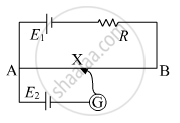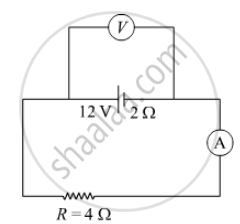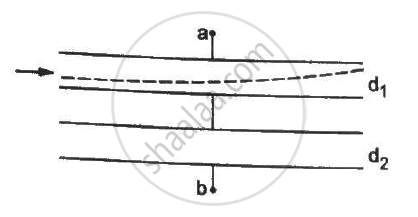Advertisements
Advertisements
Question
In the circuit diagram given below, AB is a uniform wire of resistance 15 Ω and length 1 m. It is connected to a cell E1 of emf 2V and negligible internal resistance and a resistance R. The balance point with another cell E2 of emf 75 mV is found at 30 cm from end A. Calculate the value of R.

Solution
As per the figure,
Total current through the wire AB is given by
\[I = \frac{E}{R + r}\]
\[ = \frac{2}{R + 15}\]
The potential gradient of the wire is given by
\[= I \times \frac{15}{100}\]
\[ = \frac{2}{R + 15} \times \frac{15}{100}\]
As, the balance point with cell E2 of emf 75 mV is found at 30 cm from end A
\[\frac{2}{R + 15} \times 0 . 15 \times 30 = 75 \times {10}^{- 3} \]
\[\left( \frac{2}{75 \times {10}^{- 3}} \times 0 . 15 \times 30 \right) - 15 = R\]
\[R = 105 \Omega\]
APPEARS IN
RELATED QUESTIONS
Distinguish between Conductors and Insulators.
Draw a labelled diagram of Van de Graaff generator. State its working principle to show how by introducing a small charged sphere into a larger sphere, a large amount of charge can be transferred to the outer sphere. State the use of this machine and also point out its limitations.
The potential difference applied across a given resistor is altered so that the heat produced per second increases by a factor of 9. By what factor does the applied potential difference change?
In the figure shown, an ammeter A and a resistor of 4 Ω are connected to the terminals of the source. The emf of the source is 12 V having an internal resistance of 2 Ω. Calculate the voltmeter and ammeter readings.

Explain the principle of a device that can build up high voltages of the order of a few million volts.
Both the capacitors shown in figure are made of square plates of edge a. The separations between the plates of the capacitors are d1 and d2 as shown in the figure. A potential difference V is applied between the points a and b. An electron is projected between the plates of the upper capacitor along the central line. With what minimum speed should the electron be projected so that it does not collide with any plate? Consider only the electric forces.

The unit of potential difference as used in electrical circuits is ________.
On moving a charge of Q coulomb by X cm, W J of work is done, then the potential difference between the points is ______.
- It depends only on the initial and final position.
- It is the work done per unit positive charge in moving from one point to other.
- It is more for a positive charge of two units as compared to a positive charge of one unit.
On moving a charge of 20 C by 2 cm, 2 j of work is done then the potential difference between the point is:-
